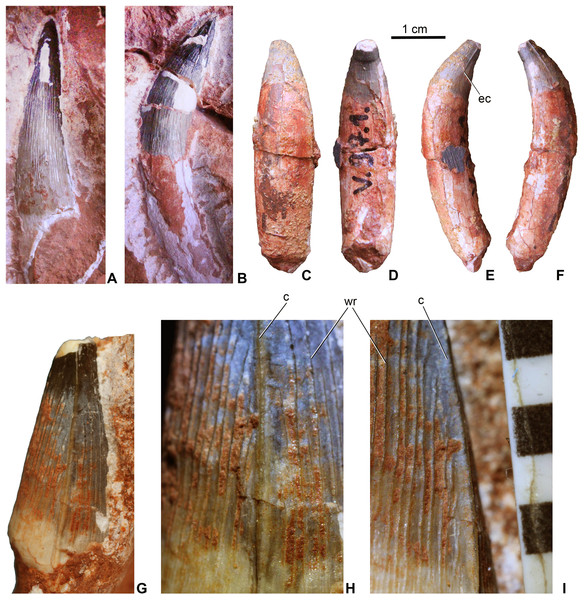@WFS,World Fossil Society,Riffin T Sajeev,Russel T Sajeev
A new large-bodied thalattosuchian crocodyliform from the Lower Jurassic (Toarcian) of Hungary, with further evidence of the mosaic acquisition of marine adaptations in Metriorhynchoidea.
(2018) PeerJ 6:e4668 https://doi.org/10.7717/peerj.4668

Mandibular elements of Magyarosuchus fitosi gen. et sp. nov. from the Toarcian of the Gerecse Mountains, Hungary.
(A), left dentary fragment (MTM V.97.2.A), middle portion in lateral; (B), dorsal views. (C), left dentary fragment (MTM V.97.2.B), posterior portion in lateral; (D), dorsal; (E), medial views. (F), dorsal (dentary + surangular) and ventral (angular) margins of the mandibular fenestra of the left mandible (MTM V.97.40) in dorsal; (G), medial; (H), lateral; (I), ventral views. Note that the specimen is dorsoventrally compressed, artificially closing the external mandibular fenestra. (J), Right? Mandible fragment (MTM V.97.2.C) in dorsal; (K), ventral; (L), lateral views. al, alveolus; an, angular; emf, external mandibular fenestra; gr, surangulodentary and angulodentary grooves; maf, mandibular adductor fossa; s, suture, sa, surangular; sh, shelf.

Teeth of Magyarosuchus fitosi gen. et sp. nov. from the Toarcian of the Gerecse Mountains, Hungary.(A), anterior tooth (MTM V.97.57.) with root fragment in labial view. (B), anterior or middle tooth (MTM V.97.57.) with root in mesial/distal view. (C), posterior tooth (MTM V.97.1) with root in labial; (D), lingual; (E), ?mesial; (F), distal views. (G), middle or posterior tooth (MTM V.97.57.) in mesial/distal views. (H and I), details of the ornamentation and the unserrated carina of (MTM V.97.57.), scale represents millimeter. c, carina; ec, end of the carina; wr, wrinkle.
Based on associated and three-dimensionally preserved cranial and postcranial remains, a new thalattosuchian crocodyliform, Magyarosuchus fitosi gen. et sp. nov. from the Lower Jurassic (Upper Toarcian) Kisgerecse Marl Formation, Gerecse Mountains, Hungary is described here. Phylogenetic analyses using three different datasets indicate that M. fitosi is the sister taxon of Pelagosaurus typus forming together the basal-most sub-clade of Metriorhynchoidea. With an estimated body length of 4.67–4.83 m M. fitosi is the largest known non-metriorhynchid metriorhynchoid. Besides expanding Early Jurassic thalattosuchian diversity, the new specimen is of great importance since, unlike most contemporaneous estuarine, lagoonal or coastal thalattosuchians, it comes from an ‘ammonitico rosso’ type pelagic deposit of the Mediterranean region of the Tethys. A distal caudal vertebra having an unusually elongate and dorsally projected neural spine implies the presence of at least a rudimentary hypocercal tail fin and a slight ventral displacement of the distal caudal vertebral column in this basal metriorhynchoid. The combination of retaining heavy dorsal and ventral armors and having a slight hypocercal tail is unique, further highlighting the mosaic manner of marine adaptations in Metriorhynchoidea.
@WFS,World Fossil Society,Riffin T Sajeev,Russel T Sajeev



 May 15th, 2018
May 15th, 2018  Riffin
Riffin  Posted in
Posted in  Tags:
Tags: 